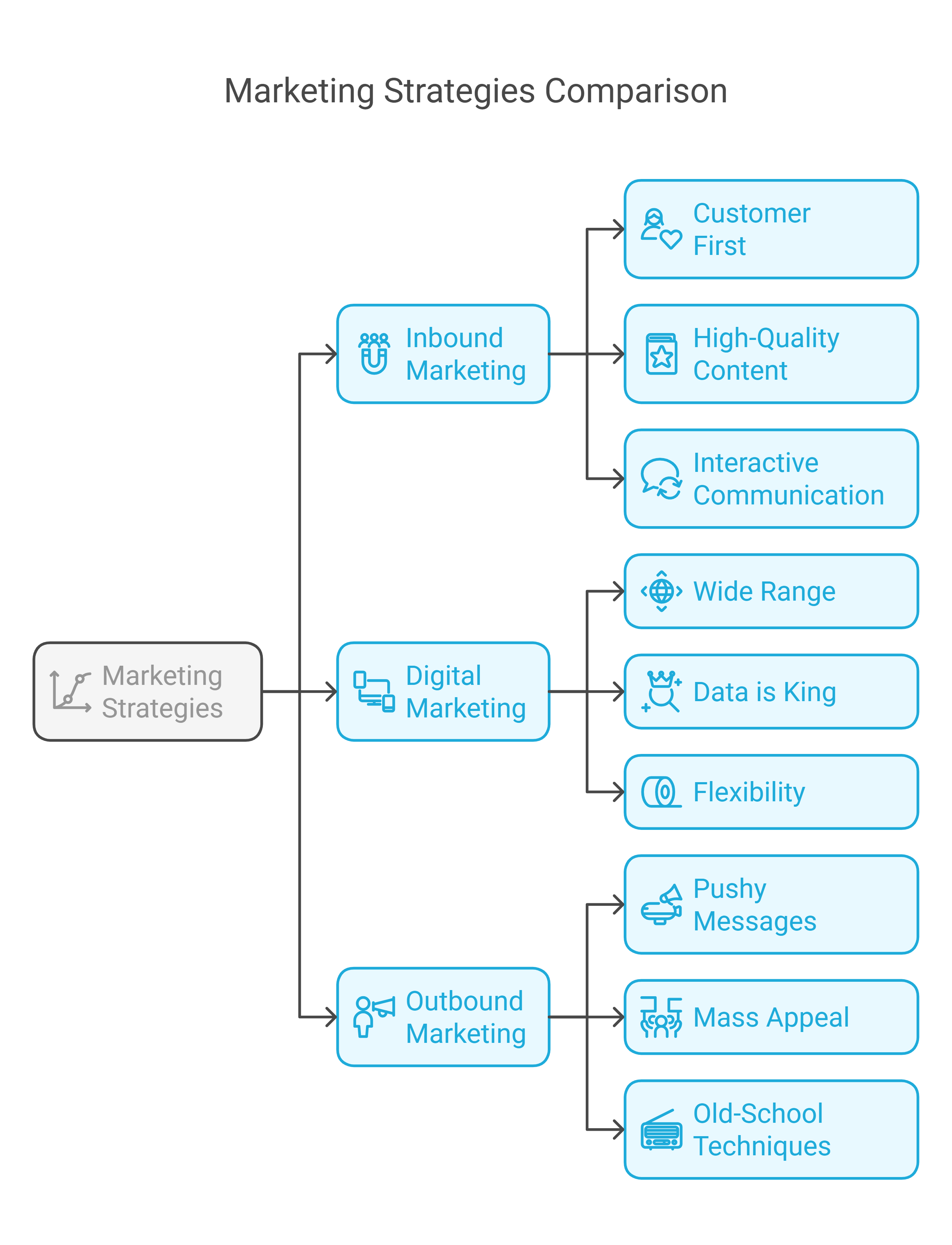Inbound Marketing Philosophy, and its Comparison to Digital and Outbound Marketing
What is Inbound Marketing?
Inbound marketing is a way of attracting customers to your business by offering them something useful and valuable. Instead of interrupting people with ads they might not care about, it focuses on creating content and experiences that naturally draw potential customers in.
- Attraction: It's like setting a trap with bait that only your ideal customers will find tempting, solving problems they have.
- Value-First: The main idea is to offer something of value to the audience before asking for a sale. Think of it like giving a free sample before asking someone to buy the full product.
Key Elements of Inbound Marketing
- Attract: Drawing in the right audience with useful content.
- Engage: Interacting with potential customers, building a two-way conversation.
- Delight: Keeping existing customers happy so they become loyal fans of your brand.
Core Principles of Inbound Marketing
- Relationships over Interruptions: Focus on building long-term relationships rather than relying on pushy advertising.
- Valuable Content: Create content that is helpful and relevant to your audience.
- Easy Discovery: Make sure your content is easy to find through good search engine optimization (SEO).
- Continuous Improvement: Regularly update and improve your content to meet customer needs.
Contrasting Inbound and Outbound Marketing
To really understand inbound marketing, it helps to see how it's different from outbound marketing, which is a more traditional approach.
| Feature | Inbound Marketing | Outbound Marketing |
|---|---|---|
| Approach | Attracts customers with valuable content | Pushes messages to a wide audience |
| Primary Focus | Customer needs and interests | Promoting products and services |
| Communication | Two-way interaction, conversations, and engagement | One-way broadcast, often interrupting |
| Content Style | Educational, helpful, and relevant to the target audience | Primarily promotional and sales-focused |
| Customer Journey | Personalized, nurturing journey | Focused on immediate conversions |
| Long-Term Impact | Builds brand loyalty and ongoing relationships | Less effective at building long-term connections |
Simple Examples:
- Outbound: Imagine a TV commercial that interrupts your favorite show or getting junk mail in your mailbox.
- Inbound: Imagine finding a blog post or video that perfectly answers a question you've been wondering about or finding a useful free tool from a brand
Inbound vs. Digital vs. Outbound Marketing
Characteristics of Inbound Marketing
- Customer First: Always focuses on what the customer wants and needs and providing value to them through content at every step of the journey.
- Attracting Rather Than Interrupting: Instead of interrupting people, it draws them to you by providing relevant content and making sure you can easily find it online.
- Long-Term View: It focuses on creating lasting connections with customers rather than trying to make a quick buck.
- High-Quality Content: Good, helpful content is at the center of inbound marketing. This is the core element to attracting, educating, and engaging your audience.
- Interactive Communication: Uses two-way conversations and engagement as key methods of contact with your audience.
- Data-Informed: Uses analytics to track the result and optimise the approach to marketing.
- The Inbound Flywheel Uses a circular approach with the stages attract, engage and delight which is core to the business strategy.
Characteristics of Digital Marketing
- Wide Range: It includes all marketing activities using digital platforms, like the internet, mobile devices, and social media.
- Platform-Focused: Uses various digital channels to promote products, build brands and communicate with the audience.
- Many Tools: Includes email marketing, social media, search engines, content, videos, mobile marketing, and more.
- Data is King: Emphasizes using analytics to make informed decisions.
- Flexibility: Allows for quick changes and adaptation.
- Choice of Approach: Digital marketing can be interruptive (like banner ads) or it can be more organic (like content marketing.)
Characteristics of Outbound Marketing
- Pushy Messages: Involves pushing a message out to a large audience, often unsolicited.
- Interruption-Based: Interrupts consumers with ads or sales messaging.
- Mass Appeal: Attempts to reach as many people as possible, whether they are interested or not.
- One-Way Communication: Often a one-way message with little interaction with the audience.
- Old-School Techniques: Uses methods like TV and radio ads, print advertising, direct mail, and cold calling.
- Quick Results Focused: Aims to make immediate sales rather than create a long lasting relationship.
- Customer Not Central The customer is usually not the main concern
- Less Targeted The messages are usually less targeted to a specific audience
- Expensive Requires high cost investment in traditional media channels.
Differences Summarized:
| Feature | Inbound | Digital | Outbound |
|---|---|---|---|
| Core Idea | Attract with value & nurture | Market using digital platforms | Push message to a mass audience |
| Method | Earns attention through useful content | Can be both, earns attention or interrupts | Interrupts users with advertising |
| Content Style | Helpful, relevant, and educational | Depends on the platform | Focus on sales and promotion |
| Goal | Build relationships & customer loyalty | Achieve marketing goals (branding/sales) | Generate immediate sales or brand recognition |
| Communication | Two-way, encourages engagement | Varies on channel. May be one-way or two-way. | Usually one-way with limited interaction |
The Short Version:
- Inbound: Think of it as inviting people to a party because you know they'll love it.
- Digital: Think of it as using all the digital ways to spread the word about your party (e.g., online invites, social posts).
- Outbound: Think of it as shouting about your party on the street whether people want to hear it or not.


No Comments